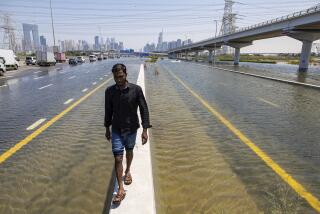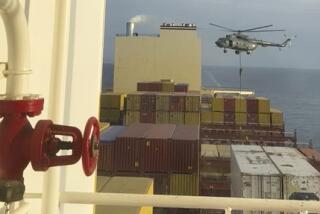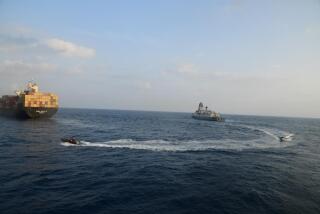Emirates Orders, Then Lifts, a Ban on Vessels in Area of Mines
- Share via
DUBAI, United Arab Emirates — This Persian Gulf federation briefly imposed, then lifted an exclusion zone around its eastern coastal waters Thursday after an air and sea search failed to turn up any more explosive charges in the area where a U.S.-owned tanker hit a mine earlier this week.
Emirates officials had declared a 50-square-mile stretch of coastal waters in the Gulf of Oman off-limits to shipping Wednesday night following the discovery of a sixth mine in the area.
All Thursday, Emirates patrol craft and helicopters stopped unidentified boats and ordered oil tanker traffic to stay out of the area, about eight miles east of the Emirates port of Fujaira, where the U.S.-owned tanker Texaco Caribbean hit a mine Monday.
More Mines Sighted
Five more unexploded mines were subsequently sighted in the vicinity, two of them in the area where the Texaco Caribbean was damaged and three of them closer to shore in the busy tanker anchorage off Fujaira.
But the exclusion zone was lifted Thursday evening when the search failed to turn up any more of the mines.
“The Coast Guard believes there are no more mines in the area, and it has now been reopened to traffic,” a maritime official in Fujaira said.
However, gulf shipping sources, speaking on condition of anonymity, said they still fear that there may be more mines in the area, which serves as a major anchorage point for supertankers waiting to pass through the Strait of Hormuz, gateway to the Persian Gulf.
“There’s a very good chance there are quite a few more mines out there, and it’s got everybody in the shipping business quite nervous,” said one maritime source.
In Oslo, according to the news agency Reuters, Per Kure, a spokesman for the Norwegian Shipowners’ Assn., said the discovery of the mines had prompted Norwegian shipowners to start extending double-time, war-risk pay rates to seaman sailing in the Gulf of Oman. Such rates had previously been paid only to those sailing in the Persian Gulf.
There are currently between 14 and 18 Norwegian vessels in the gulf region.
The association had warned Norwegian ships to steer clear of Fujaira after the Texaco Caribbean was damaged.
Another source, a demolition expert with extensive experience in the gulf region, said he believes the mines sighted on the surface of the Gulf of Oman over the last four days should have been laid 20 to 30 feet underwater, where they could not be seen but where an oil-laden supertanker would hit them.
“Maybe they’ve found all the mines. But it’s also very possible that the ones they found were just the failures,” he said. “If that is so, then there may be more out there, under the water where we can’t see them.”
Ships Warned Away
Emirates officials had declared the northern half of the Fujaira anchorage a danger zone and maritime sources said ships were being warned away from a coastal area, about five miles wide by 10 miles deep, between Fujaira and the port of Khawr Fakkan, 10 miles further up the Emirates coast.
The port at Fujaira itself remained open and shipping traffic was passing normally through the Strait of Hormuz, about 30 miles off the northern tip of the Emirates coast, shipping sources said.
Nevertheless, the sources said the presence of mines in the area is an extremely serious and unsettling development because it is the first time in the almost-seven-year-old war between Iran and Iraq that mines have been planted outside the Persian Gulf.
“It represents a significant widening of the theater of conflict. Fujaira until now was considered the last safe anchorage before entering the gulf,” one shipping source said.
Saudi Vessel Hits Mine
Earlier in the day, the Associated Press quoted Saudi Arabian police as saying, a Saudi coast guard vessel hit a mine in the northern end of the Persian Gulf, and two crewmen were injured slightly. The incident occurred 10 to 20 miles off the village of Khafji, more than 550 miles northwest of the Fujaira anchorage, according to a police officer in the village who declined to give further details.
Although Tehran has denied it, it is virtually taken for granted among diplomats and shipping officials here that the mines were planted by boats operated by Iranian Revolutionary Guards naval units.
In Washington, Pentagon spokesman Robert B. Sims said Thursday that the mines almost certainly had been planted by Iran.
“We believe that it is quite likely, in fact, almost certainly, the Iranians who left those mines there, presumably in hopes of placing them in front of our most recent tanker escort group,” Sims said.
No ‘Specific Evidence’
Last weekend, U.S. Navy warships escorted three Kuwaiti tankers from the Gulf of Oman through the Strait of Hormuz, arriving safely in Kuwait late Tuesday.
Sims said that Pentagon officials had no “specific evidence” that Iran was responsible for the mines “but almost certainly, the ones that were placed in the Gulf of Oman were, like others, placed by Iran. That’s the general assessment that we make.”
Sims refused to elaborate on how the Pentagon had reached that assessment. But other officials, who requested anonymity, said the mines appeared to be of the same type that Iran is thought to have planted inside the Persian Gulf.
Sims did disclose that U.S. Navy warships had escorted another American vessel, the Courier, into the gulf “within the past day or so.”
“This is one of those that’s chartered by the Military Sealift Command to carry oil and jet fuel to and from our forces in the area there,” he added. Kuwait is providing fuel for American warships, planes and helicopters in partial payment for the U.S. military escort of its tankers.
Times staff writer John Broder, in Washington, contributed to this article.
More to Read
Sign up for Essential California
The most important California stories and recommendations in your inbox every morning.
You may occasionally receive promotional content from the Los Angeles Times.










